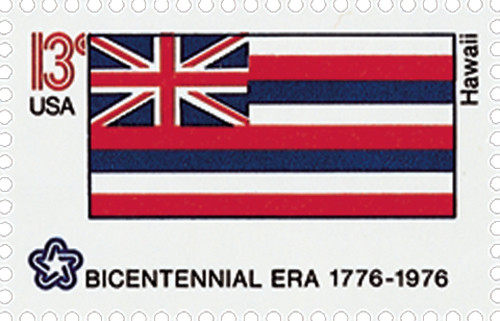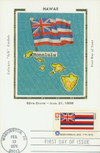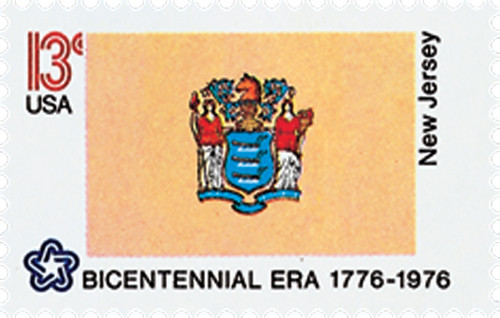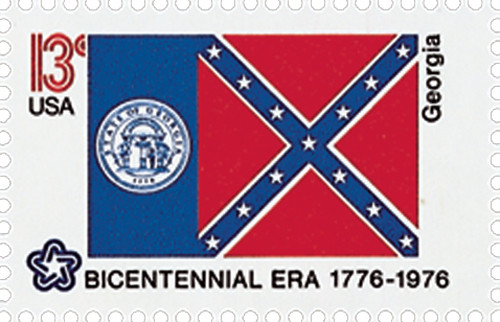
# 1682 - 1976 13c State Flags: Hawaii
U.S. 1682
1976 Hawaii
State Flags
American Bicentennial Series
• First time a sheet 50 had all different stamp designs
• Part of the American Bicentennial Series
Stamp Category: Commemorative
Series: American Bicentennial Series
Value: 13¢ First-class postage rate
First Day of Issue: February 23, 1976
First Day City(s): Washington, DC
Quantity Issued: 8,720,100 (panes of 50)
Printed by: Bureau of Engraving and Printing
Printing Method: Photogravure
Format: Sheet of 50
Perforations: 11
Why the stamp was issued:
The United States Postal Service celebrated the American Bicentennial with a full pane of the Union’s fifty state flags.
About the stamp design:
Hawaii’s state flag has remained virtually unchanged since its creation in 1816. At the time, Hawaii was an independent kingdom under the rule of Kamehameha the Great, who commissioned the creation of a flag. The resulting flag consisted of eight red, white, and blue stripes with the flag of Great Britain in the upper-left corner. The eight stripes represent the eight main islands of Hawaii, while the Union Jack (another name for the flag of Great Britain) symbolizes the friendship between Hawaii and Great Britain. In 1959, when Hawaii was admitted as the 50th state of the United States, the flag was officially adopted as the state flag of Hawaii.
About the printing process:
Printed by the Bureau of Engraving and Printing on their seven-color Andreotti gravure press (601) which was their work horse for multicolored stamps.
About the American Bicentennial Series:
In the 1970s, America celebrated its 200th anniversary with hundreds of national events commemorating the heroes and historic events that led to our nation’s independence from Great Britain. The U.S. Postal Service issued 113 commemorative stamps over a six-year period in honor of the U.S. bicentennial, beginning with the American Revolution Bicentennial Commission Emblem stamp (U.S. #1432). As a group, the Bicentennial Series chronicles one of our nation’s most important chapters, and remembers the events and patriots who made the U.S. a world model for liberty.
Several of the stamps honored colonial life – craftsmen and communication. Other stamps honored important battles including Lexington and Concord, Bunker Hill, and Saratoga. Significant events such as the Boston Tea Party, the meeting of the First Continental Congress, and the Declaration of Independence were featured as well. The stamps also honored many significant people such as George Washington, Sybil Ludington, Salem Poor, and the Marquis de Lafayette.
Many of the stamps feature classic artwork. For instance, the set of four souvenir sheets picture important events recreated by noted artists such as John Trumbull. The Bicentennial Series also includes an important US postal first – the first 50-stamp se-tenant – featuring all 50 state flags. The format proved to be popular with collectors, and has been repeated many times since.
The American Bicentennial Series is packed with important US history – it tells the story of our nation’s fight for independence through stamps.
History the stamp represents:
On August 21, 1959, Hawaii became the 50th and last US state.
Polynesians were the first people to settle the Hawaiian Islands. They journeyed across the Pacific, moving from island to island in giant canoes. They probably reached Hawaii around 2,000 years ago. Another group from Tahiti reached the islands in AD 1200 and conquered the earlier settlers. The name Hawaii is either derived from the name of a chief, Hawai’iloa, or the legendary name of the Polynesian homeland to the west, Hawaiki.
Although European or Japanese ships may have reached the Hawaiian Islands during the 1500s, Great Britain’s Captain James Cook was responsible for making them known to the rest of the world. Cook landed there on January 18, 1778, and engaged in friendly trade. It’s estimated that about 300,000 people lived in Hawaii at that time. The Hawaiians believed Cook had divine powers and considered him a great chief. He named the islands in honor of the first lord of the British admiralty, the Earl of Sandwich. Cook left the Sandwich Islands after two weeks. He returned in November 1778, and was later killed when a fight broke out between the Hawaiians and his men.
Cook’s voyages brought more explorers and traders to Hawaii. The first trading ship stopped there in 1786 while transporting a load of furs from Oregon to China. New types of livestock, manufactured goods, and plants were introduced to the islands. Unfortunately, new diseases took a devastating toll on the islanders.
Local chiefs had controlled the islands throughout Hawaii’s history. In 1782, Chief Kamehameha obtained firearms from European traders and began a bloody war to unite the islands into a kingdom. By 1792, he controlled Hawaii Island. Three years later, he controlled all the main islands except Kauai and Niihau. Kamehameha appointed the local chiefs as governors and proclaimed himself King Kamehameha I. The chiefs of Kauai and Niihau accepted Kamehameha’s rule in 1810.
From 1811 to 1830, Hawaii shipped great supplies of sandalwood to China. Money from this lucrative trade allowed the Hawaiians to purchase weapons, ships, and other supplies. From then until the 1860s, Hawaii’s greatest source of income was the sale of fresh water and other supplies to whaling ships. The first permanent sugar cane plantation in Hawaii was started at Koloa on Kauai Island in 1835. In 1885, the first pineapples were brought to the islands from Jamaica. The plants were imported by the British horticulturist Captain John Kidwell. Even today, sugar cane and pineapples remain Hawaii’s most profitable crops.
Kamehameha’s son, crowned Kamehameha II in 1819, banned the official religion of the Hawaiian Kingdom and disbanded its orders of priests. In 1820, the American Board of Commissioners for Foreign Missions sent Protestant missionaries and teachers to the islands. Most Hawaiians converted to Christianity. In 1827, Roman Catholic missionaries arrived. These missionaries met resistance from the chiefs who considered Protestantism the official religion. The Roman Catholics were forced to leave in 1831. Efforts were made to prevent new Catholics from arriving, and many Hawaiians practicing Catholicism were jailed. In July 1839, French Captain C. P. T. Laplace of the frigate L’Artémise blockaded Honolulu. Laplace demanded Roman Catholics have religious freedom and threatened to destroy Honolulu. As a result, the Hawaiians granted the Catholics their freedom.
Hawaii adopted its first constitution in 1840. It provided for an executive, a legislature, and a supreme court. The legislature consisted of a house of chiefs and a house of elected representatives. The United States recognized Hawaii as an independent government in 1842.
Before 1848, the king owned all the land in Hawaii. That year, land reforms were enacted under the Great Māhele. Land was distributed to chiefs who divided it into homesteads. Some land was sold to foreigners. From 1854 to 1900, Hawaii’s economic opportunities attracted a great number of foreigners. Chinese, Polynesians, Japanese, Portuguese, Filipinos, Koreans, and Puerto Ricans all came to the islands.
King Kalakaua gave the US the right to use Pearl Harbor as a naval base in 1887 in return for trading privileges. In 1891, Kalakaua died and his sister was crowned Queen Liluokalani. Liluokalani attempted to install a new constitution that would increase her power. In 1893, a group of nine Americans, two Britons, and two Germans led a revolution against Liluokalani, removing her from office. The revolutionaries were aided by US marines and sailors. In 1894, the Republic of Hawaii was formed. This short-lived nation had just one president, Sanford B. Dole.
Hawaii came under the control of US businessmen. These businessmen lobbied for Hawaii to be annexed by the US – which was financially beneficial to their interests. On August 12, 1898, the islands were officially annexed and became US possessions. Hawaii became a US territory on June 14, 1900, and Hawaiians became US citizens. However, their congressional representative could not vote and the US Congress could veto any law passed by their legislature.
On December 7, 1941, the Japanese attacked the US naval base at Pearl Harbor and airfields on Oahu. The surprise attack brought the US into World War II. Hawaii was under martial law from 1941 to 1944, although little more fighting took place there.
The first bill attempting to make Hawaii a state was introduced in 1919. In 1950, Hawaii adopted a constitution in preparation for statehood. Congress approved the appropriate legislation in 1959 and President Dwight D. Eisenhower signed the bill. The matter went before the Hawaiian people, who voted 17 to 1 in favor of statehood. On August 21, 1959, Hawaii became a US state.
U.S. 1682
1976 Hawaii
State Flags
American Bicentennial Series
• First time a sheet 50 had all different stamp designs
• Part of the American Bicentennial Series
Stamp Category: Commemorative
Series: American Bicentennial Series
Value: 13¢ First-class postage rate
First Day of Issue: February 23, 1976
First Day City(s): Washington, DC
Quantity Issued: 8,720,100 (panes of 50)
Printed by: Bureau of Engraving and Printing
Printing Method: Photogravure
Format: Sheet of 50
Perforations: 11
Why the stamp was issued:
The United States Postal Service celebrated the American Bicentennial with a full pane of the Union’s fifty state flags.
About the stamp design:
Hawaii’s state flag has remained virtually unchanged since its creation in 1816. At the time, Hawaii was an independent kingdom under the rule of Kamehameha the Great, who commissioned the creation of a flag. The resulting flag consisted of eight red, white, and blue stripes with the flag of Great Britain in the upper-left corner. The eight stripes represent the eight main islands of Hawaii, while the Union Jack (another name for the flag of Great Britain) symbolizes the friendship between Hawaii and Great Britain. In 1959, when Hawaii was admitted as the 50th state of the United States, the flag was officially adopted as the state flag of Hawaii.
About the printing process:
Printed by the Bureau of Engraving and Printing on their seven-color Andreotti gravure press (601) which was their work horse for multicolored stamps.
About the American Bicentennial Series:
In the 1970s, America celebrated its 200th anniversary with hundreds of national events commemorating the heroes and historic events that led to our nation’s independence from Great Britain. The U.S. Postal Service issued 113 commemorative stamps over a six-year period in honor of the U.S. bicentennial, beginning with the American Revolution Bicentennial Commission Emblem stamp (U.S. #1432). As a group, the Bicentennial Series chronicles one of our nation’s most important chapters, and remembers the events and patriots who made the U.S. a world model for liberty.
Several of the stamps honored colonial life – craftsmen and communication. Other stamps honored important battles including Lexington and Concord, Bunker Hill, and Saratoga. Significant events such as the Boston Tea Party, the meeting of the First Continental Congress, and the Declaration of Independence were featured as well. The stamps also honored many significant people such as George Washington, Sybil Ludington, Salem Poor, and the Marquis de Lafayette.
Many of the stamps feature classic artwork. For instance, the set of four souvenir sheets picture important events recreated by noted artists such as John Trumbull. The Bicentennial Series also includes an important US postal first – the first 50-stamp se-tenant – featuring all 50 state flags. The format proved to be popular with collectors, and has been repeated many times since.
The American Bicentennial Series is packed with important US history – it tells the story of our nation’s fight for independence through stamps.
History the stamp represents:
On August 21, 1959, Hawaii became the 50th and last US state.
Polynesians were the first people to settle the Hawaiian Islands. They journeyed across the Pacific, moving from island to island in giant canoes. They probably reached Hawaii around 2,000 years ago. Another group from Tahiti reached the islands in AD 1200 and conquered the earlier settlers. The name Hawaii is either derived from the name of a chief, Hawai’iloa, or the legendary name of the Polynesian homeland to the west, Hawaiki.
Although European or Japanese ships may have reached the Hawaiian Islands during the 1500s, Great Britain’s Captain James Cook was responsible for making them known to the rest of the world. Cook landed there on January 18, 1778, and engaged in friendly trade. It’s estimated that about 300,000 people lived in Hawaii at that time. The Hawaiians believed Cook had divine powers and considered him a great chief. He named the islands in honor of the first lord of the British admiralty, the Earl of Sandwich. Cook left the Sandwich Islands after two weeks. He returned in November 1778, and was later killed when a fight broke out between the Hawaiians and his men.
Cook’s voyages brought more explorers and traders to Hawaii. The first trading ship stopped there in 1786 while transporting a load of furs from Oregon to China. New types of livestock, manufactured goods, and plants were introduced to the islands. Unfortunately, new diseases took a devastating toll on the islanders.
Local chiefs had controlled the islands throughout Hawaii’s history. In 1782, Chief Kamehameha obtained firearms from European traders and began a bloody war to unite the islands into a kingdom. By 1792, he controlled Hawaii Island. Three years later, he controlled all the main islands except Kauai and Niihau. Kamehameha appointed the local chiefs as governors and proclaimed himself King Kamehameha I. The chiefs of Kauai and Niihau accepted Kamehameha’s rule in 1810.
From 1811 to 1830, Hawaii shipped great supplies of sandalwood to China. Money from this lucrative trade allowed the Hawaiians to purchase weapons, ships, and other supplies. From then until the 1860s, Hawaii’s greatest source of income was the sale of fresh water and other supplies to whaling ships. The first permanent sugar cane plantation in Hawaii was started at Koloa on Kauai Island in 1835. In 1885, the first pineapples were brought to the islands from Jamaica. The plants were imported by the British horticulturist Captain John Kidwell. Even today, sugar cane and pineapples remain Hawaii’s most profitable crops.
Kamehameha’s son, crowned Kamehameha II in 1819, banned the official religion of the Hawaiian Kingdom and disbanded its orders of priests. In 1820, the American Board of Commissioners for Foreign Missions sent Protestant missionaries and teachers to the islands. Most Hawaiians converted to Christianity. In 1827, Roman Catholic missionaries arrived. These missionaries met resistance from the chiefs who considered Protestantism the official religion. The Roman Catholics were forced to leave in 1831. Efforts were made to prevent new Catholics from arriving, and many Hawaiians practicing Catholicism were jailed. In July 1839, French Captain C. P. T. Laplace of the frigate L’Artémise blockaded Honolulu. Laplace demanded Roman Catholics have religious freedom and threatened to destroy Honolulu. As a result, the Hawaiians granted the Catholics their freedom.
Hawaii adopted its first constitution in 1840. It provided for an executive, a legislature, and a supreme court. The legislature consisted of a house of chiefs and a house of elected representatives. The United States recognized Hawaii as an independent government in 1842.
Before 1848, the king owned all the land in Hawaii. That year, land reforms were enacted under the Great Māhele. Land was distributed to chiefs who divided it into homesteads. Some land was sold to foreigners. From 1854 to 1900, Hawaii’s economic opportunities attracted a great number of foreigners. Chinese, Polynesians, Japanese, Portuguese, Filipinos, Koreans, and Puerto Ricans all came to the islands.
King Kalakaua gave the US the right to use Pearl Harbor as a naval base in 1887 in return for trading privileges. In 1891, Kalakaua died and his sister was crowned Queen Liluokalani. Liluokalani attempted to install a new constitution that would increase her power. In 1893, a group of nine Americans, two Britons, and two Germans led a revolution against Liluokalani, removing her from office. The revolutionaries were aided by US marines and sailors. In 1894, the Republic of Hawaii was formed. This short-lived nation had just one president, Sanford B. Dole.
Hawaii came under the control of US businessmen. These businessmen lobbied for Hawaii to be annexed by the US – which was financially beneficial to their interests. On August 12, 1898, the islands were officially annexed and became US possessions. Hawaii became a US territory on June 14, 1900, and Hawaiians became US citizens. However, their congressional representative could not vote and the US Congress could veto any law passed by their legislature.
On December 7, 1941, the Japanese attacked the US naval base at Pearl Harbor and airfields on Oahu. The surprise attack brought the US into World War II. Hawaii was under martial law from 1941 to 1944, although little more fighting took place there.
The first bill attempting to make Hawaii a state was introduced in 1919. In 1950, Hawaii adopted a constitution in preparation for statehood. Congress approved the appropriate legislation in 1959 and President Dwight D. Eisenhower signed the bill. The matter went before the Hawaiian people, who voted 17 to 1 in favor of statehood. On August 21, 1959, Hawaii became a US state.


















